Nancy Kelly Allen's Blog, page 7
June 24, 2018
Chapter Book Revision, continued
In my revision, I’ve reviewed the setting and made sure I let the reader know where the story is happening. The action takes place in a park, in present day, for the duration of three days. The setting provides the backdrop for the action, and that allows me to use sensory language to evoke vivid sights, aromas, and slimy tactile sensations, in this case—snot! Snot works for the chapter book age group.
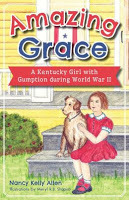
The park setting is the backdrop for the conflict, too, from sneaky bullies inside buildings, to finding hidden cave treasures on a hillside, to a deep diving escape in the swimming pool. Nights can be dark with only firelight to see. Sunny days can offer an environment for soundless steps on a mossy bank, perfect for sneaking up on wild goats. I’ve used setting to enhance the conflict and raise the tension. The thesaurus has come in handy in choosing descriptive words and phrases to create the mood of the story. In revising, I’ve tweaked the scenes to make the setting a part of the story narrative, rather than merely describing it, to keep the reader immersed in the fictional world.
Conflict/problem builds reader interest. I introduced part of the conflict in the first chapter, hinted about another conflict in the second chapter, and fully introduced the other conflict in the third chapter. The goal of the main character is to attend a weather camp weekend at the park, but because he has a problem with a neighbor, he is grounded (the initial conflict). The conflict arises in the first chapter and gives the story direction.
In my next blog, I’ll discuss more elements of revision.
Call for Submissions for Adult Writers:
FrostFire Worlds is intended for younger readers, from ages 8-17 and up. Genre: Science fiction and fantasy short stories, poems, art, articles, reviews, and interviews. Preferred are adventure stories, space opera, and magic opera [like space opera, but fantasy]. Also preferred are stories that take place on other worlds. Stories must have the following: characters the reader cares about, plots and subplots, and settings that draw the reader into them.Submission guidelines athttp://albanlake.com/guidelines-frost...
Nancy Kelly Allen has written 40+ children’s books and a cookbook, SPIRIT OF KENTUCKY: BOURBON COOKBOOK.
Leave a message or check out my blog at www.nancykellyallen.com

The park setting is the backdrop for the conflict, too, from sneaky bullies inside buildings, to finding hidden cave treasures on a hillside, to a deep diving escape in the swimming pool. Nights can be dark with only firelight to see. Sunny days can offer an environment for soundless steps on a mossy bank, perfect for sneaking up on wild goats. I’ve used setting to enhance the conflict and raise the tension. The thesaurus has come in handy in choosing descriptive words and phrases to create the mood of the story. In revising, I’ve tweaked the scenes to make the setting a part of the story narrative, rather than merely describing it, to keep the reader immersed in the fictional world.
Conflict/problem builds reader interest. I introduced part of the conflict in the first chapter, hinted about another conflict in the second chapter, and fully introduced the other conflict in the third chapter. The goal of the main character is to attend a weather camp weekend at the park, but because he has a problem with a neighbor, he is grounded (the initial conflict). The conflict arises in the first chapter and gives the story direction.
In my next blog, I’ll discuss more elements of revision.
Call for Submissions for Adult Writers:
FrostFire Worlds is intended for younger readers, from ages 8-17 and up. Genre: Science fiction and fantasy short stories, poems, art, articles, reviews, and interviews. Preferred are adventure stories, space opera, and magic opera [like space opera, but fantasy]. Also preferred are stories that take place on other worlds. Stories must have the following: characters the reader cares about, plots and subplots, and settings that draw the reader into them.Submission guidelines athttp://albanlake.com/guidelines-frost...
Nancy Kelly Allen has written 40+ children’s books and a cookbook, SPIRIT OF KENTUCKY: BOURBON COOKBOOK.
Leave a message or check out my blog at www.nancykellyallen.com
Published on June 24, 2018 05:58
June 10, 2018
Chapter Book Revision, continued
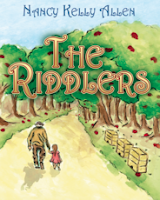 When I revise, I focus on one or two elements at a time. In this latest revision, I worked on changing an unreliable protagonist to a somewhat reliable one. That’s all I worked on, and limited that work to the first three chapters. Once I get the first three chapters polished, I’ll revise the remainder of the book, still focused on the aspects of correcting the actions of an unreliable narrator. At that point, I will begin at Chapter 1 and revise two more elements. I choose to work on one or two elements at a time, so I remain focused on those corrections, alone. If I attempt to revise everything, chapter-by-chapter, I lose focus. Other writers might be able to, but not this one.
When I revise, I focus on one or two elements at a time. In this latest revision, I worked on changing an unreliable protagonist to a somewhat reliable one. That’s all I worked on, and limited that work to the first three chapters. Once I get the first three chapters polished, I’ll revise the remainder of the book, still focused on the aspects of correcting the actions of an unreliable narrator. At that point, I will begin at Chapter 1 and revise two more elements. I choose to work on one or two elements at a time, so I remain focused on those corrections, alone. If I attempt to revise everything, chapter-by-chapter, I lose focus. Other writers might be able to, but not this one. My goal is to intrigue the reader with a character. Here’s a quick method that’s worth your time. Reread the first five pages of your manuscript. From those five pages only, list what the reader knows about the character. If you list only two or three items, revise. If you list eight to ten items, you’re off to a great start on character development. Spend time developing the main character, because the protagonist will carry the story from beginning to end.
Why am I spending so much time on the first part of the book? I have to grab the reader’s attention immediately and hold it. If the dialog, characters, and plot don’t resonate, the pages won’t be turned. I've also been working on narrative voice, the use of language that says what it says in an interesting way: phrasing that tickles the ear or surprises in some way, unexpected narrative, and age-appropriate dialog. The dialog should promote the plot or help develop the character. Read it aloud. How does it sound? Does it sound like the age of the reader?
By honing in on one or two elements, writers give full attention to correcting or improving each. If revision in one swoop through the manuscript becomes overwhelming, give this method a go.
That’s not all. In my next blog, I’ll discuss more elements of revision.
Call for Submissions for Adult Writers: Youth Imagination publishes stories relevant to teens. Genres: Fiction, including modern, urban or classical fantasy, as well as sci-fi, slipstream, literary, action-adventure or suspense. "We particularly love stories exploring their issues, such as bullying, drugs, romance, school, parental issues, teacher issues, etc., as well as about the grit and character of teens and young adults."Submission guidelines athttps://youthimagination.org/index.ph...
Nancy Kelly Allen has written 40+ children’s books and a cookbook, SPIRIT OF KENTUCKY: BOURBON COOKBOOK.
Leave a message or check out my blog at www.nancykellyallen.com
Published on June 10, 2018 05:05
May 27, 2018
Chapter Book Revision, cont'd.
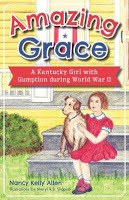 At this point in my chapter book revision, I’m focusing on the first three chapters, since that’s what many agents/editors request. If they like the beginning, they may ask to see the entire manuscript. The first sentence, followed by the first paragraph, followed by the first chapter are the parts of a manuscript that have the greatest initial impact (first chapter = initial impact). If readers aren’t hooked in the first chapter, they often read no further. A great first chapter warrents further reading. A not-so-great one earns a rejection. The writing must stand out to the point it beats the competition, which is not an easy task to achieve, but IS achievable.
At this point in my chapter book revision, I’m focusing on the first three chapters, since that’s what many agents/editors request. If they like the beginning, they may ask to see the entire manuscript. The first sentence, followed by the first paragraph, followed by the first chapter are the parts of a manuscript that have the greatest initial impact (first chapter = initial impact). If readers aren’t hooked in the first chapter, they often read no further. A great first chapter warrents further reading. A not-so-great one earns a rejection. The writing must stand out to the point it beats the competition, which is not an easy task to achieve, but IS achievable.A lot happens in the first chapter. Here are revision checkpoints I’m homing in on:
Introduce the hook. A hook is writing that snares readers' interest and keeps them reading. Introduce the characters. Begin with the main protagonist. My initial plan involved writing about an unreliable narrator, one who the reader could not depend on to tell the story in an unbiased way. The little boy didn’t get along with his neighbor so from his perspective, everything about the neighbor was negative. A few revisions later I still kept this aspect of the character’s personality. Then, after setting the story aside for months, I’ve decided to make the character narrating the story more reliable and the neighbor can come to life showing her positive and negative traits as the story unfolds. Setting this story aside to work on other projects allows me to be more objective in critiquing because I’m coming back to it with a fresh outlook, a policy I recommend for all writers.
I’ve revised the first three chapters until my fingers tingled, but Chapter 1 is missing the mark, still. What’s a writer to do? Revise, revise, revise. At this point I’ve rewritten the opening about thirty times. Yes, 30! There may be a 31. I’ll run it by my critique partner and find out.
In my next blog, I’ll provide more checkpoints for revision. Call for Submissions for Adult Writers: Hunger Mountain is a print journal of the arts. We publish fiction, poetry, creative nonfiction, visual art, young adult and children’s writing, and literary miscellany. Our print issue comes out annually in the spring. Hunger Mountain hosts four annual writing contests, which are open to all writers: the Howard Frank Mosher Short Fiction Prize, the Ruth Stone Poetry Prize, the Katherine Paterson Prize for Young Adult and Children’s Writing, and the Hunger Mountain Creative Nonfiction Prize. We also offer a paid Hunger Mountain Fellowship.
Submission guidelines at http://hungermtn.org/about-us/
Nancy Kelly Allen has written 40+ children’s books and a cookbook, SPIRIT OF KENTUCKY: BOURBON COOKBOOK.
Leave a message or check out my blog at www.nancykellyallen.com
Published on May 27, 2018 05:38
May 13, 2018
CHAPTER BOOKS Characteristics
As young readers (ages 6-9 or 10) transition from short sentences to paragraphs, chapter books become the reading selection of choice. These books are often written as a series, and story is not as dependent upon the illustrations as are those in picture books and beginning readers. Prose carries the story in chapter books along with numerous illustrations. These books bridge the gap between beginning readers and middle grade novels.
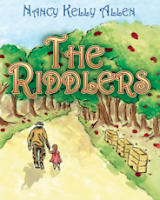 Chapter books are written in a wide variety of interests: humor, adventure, supernatural, mystery, and more. Although they differ, they share these similarities: Fast paced—the story/plot moves quickly.Fun to read with loveable/enjoyable charactersPlots are clear and simple.A protagonist who is good or means well even if the behavior is questionable. Make it clear to the reader why the character is misbehaving. Characters can be mischievous and make mistakes.Lots of dialog. The voice of the characters should sound like a child whose age is approximately that of the reader (ages 6-9). In comparison to middle grade novels, chapter books have shorter sentences, paragraphs, and chapters. Omit unnecessary words, but sometimes long words can be used if the meaning is made clear by the text or the meaning is evident by sounding out the words. Chapter lengths range from 4,000 to 15,000 words. Interesting, lively language.Humor rules…and sells. Kids love to laugh. Editors love books that make kids laugh.The child protagonist outwits the bad guys.Events can be dramatic. The characters can, and should, experience heightened emotions, including but not limited to joy, embarrassment, or fear (the fear shouldn’t be nightmarish).Most stories are told through the viewpoint of a single character.
Chapter books are written in a wide variety of interests: humor, adventure, supernatural, mystery, and more. Although they differ, they share these similarities: Fast paced—the story/plot moves quickly.Fun to read with loveable/enjoyable charactersPlots are clear and simple.A protagonist who is good or means well even if the behavior is questionable. Make it clear to the reader why the character is misbehaving. Characters can be mischievous and make mistakes.Lots of dialog. The voice of the characters should sound like a child whose age is approximately that of the reader (ages 6-9). In comparison to middle grade novels, chapter books have shorter sentences, paragraphs, and chapters. Omit unnecessary words, but sometimes long words can be used if the meaning is made clear by the text or the meaning is evident by sounding out the words. Chapter lengths range from 4,000 to 15,000 words. Interesting, lively language.Humor rules…and sells. Kids love to laugh. Editors love books that make kids laugh.The child protagonist outwits the bad guys.Events can be dramatic. The characters can, and should, experience heightened emotions, including but not limited to joy, embarrassment, or fear (the fear shouldn’t be nightmarish).Most stories are told through the viewpoint of a single character.
Read lots of chapter books to gain an understanding of what publishers are looking for in these tales.
Call for Submissions for Adult Writers:Golden Fleece Press. Submissions for Wee Tales and Refractionsmust be age appropriate for the journal (7 to 12 for Wee Tales, 13 and up for Refractions). Refractions short submissions should be between 1000 and 5000 words, Wee Tales submissions should be between 600 and 2000 words.
Submit to GFPsubmissions@gmail.com Subject line: QUERY–Title–Last NameNancy Kelly Allen has written 40+ children’s books and a cookbook, SPIRIT OF KENTUCKY: BOURBON COOKBOOK.
Leave a message or check out my blog at www.nancykellyallen.com. My Website is www.nancykellyallen.com.
 Chapter books are written in a wide variety of interests: humor, adventure, supernatural, mystery, and more. Although they differ, they share these similarities: Fast paced—the story/plot moves quickly.Fun to read with loveable/enjoyable charactersPlots are clear and simple.A protagonist who is good or means well even if the behavior is questionable. Make it clear to the reader why the character is misbehaving. Characters can be mischievous and make mistakes.Lots of dialog. The voice of the characters should sound like a child whose age is approximately that of the reader (ages 6-9). In comparison to middle grade novels, chapter books have shorter sentences, paragraphs, and chapters. Omit unnecessary words, but sometimes long words can be used if the meaning is made clear by the text or the meaning is evident by sounding out the words. Chapter lengths range from 4,000 to 15,000 words. Interesting, lively language.Humor rules…and sells. Kids love to laugh. Editors love books that make kids laugh.The child protagonist outwits the bad guys.Events can be dramatic. The characters can, and should, experience heightened emotions, including but not limited to joy, embarrassment, or fear (the fear shouldn’t be nightmarish).Most stories are told through the viewpoint of a single character.
Chapter books are written in a wide variety of interests: humor, adventure, supernatural, mystery, and more. Although they differ, they share these similarities: Fast paced—the story/plot moves quickly.Fun to read with loveable/enjoyable charactersPlots are clear and simple.A protagonist who is good or means well even if the behavior is questionable. Make it clear to the reader why the character is misbehaving. Characters can be mischievous and make mistakes.Lots of dialog. The voice of the characters should sound like a child whose age is approximately that of the reader (ages 6-9). In comparison to middle grade novels, chapter books have shorter sentences, paragraphs, and chapters. Omit unnecessary words, but sometimes long words can be used if the meaning is made clear by the text or the meaning is evident by sounding out the words. Chapter lengths range from 4,000 to 15,000 words. Interesting, lively language.Humor rules…and sells. Kids love to laugh. Editors love books that make kids laugh.The child protagonist outwits the bad guys.Events can be dramatic. The characters can, and should, experience heightened emotions, including but not limited to joy, embarrassment, or fear (the fear shouldn’t be nightmarish).Most stories are told through the viewpoint of a single character.Read lots of chapter books to gain an understanding of what publishers are looking for in these tales.
Call for Submissions for Adult Writers:Golden Fleece Press. Submissions for Wee Tales and Refractionsmust be age appropriate for the journal (7 to 12 for Wee Tales, 13 and up for Refractions). Refractions short submissions should be between 1000 and 5000 words, Wee Tales submissions should be between 600 and 2000 words.
Submit to GFPsubmissions@gmail.com Subject line: QUERY–Title–Last NameNancy Kelly Allen has written 40+ children’s books and a cookbook, SPIRIT OF KENTUCKY: BOURBON COOKBOOK.
Leave a message or check out my blog at www.nancykellyallen.com. My Website is www.nancykellyallen.com.
Published on May 13, 2018 06:44
April 29, 2018
Writing a Chapter Book
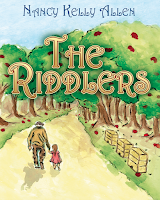 I’m in the process of revising a chapter book manuscript. I wrote it about two years ago, revised it a few times, and then placed it aside to work on picture books. Now, it’s time to revisit the manuscript. Waiting a few months before revision is important so I can visualize the text with fresh eyes and a clearer editorial sense. Usually, I don’t wait this long, but I want to give this story the best chance possible for publication. Letting time pass without reading it will make it easier to recognize the weaknesses of the story and the mistakes.
I’m in the process of revising a chapter book manuscript. I wrote it about two years ago, revised it a few times, and then placed it aside to work on picture books. Now, it’s time to revisit the manuscript. Waiting a few months before revision is important so I can visualize the text with fresh eyes and a clearer editorial sense. Usually, I don’t wait this long, but I want to give this story the best chance possible for publication. Letting time pass without reading it will make it easier to recognize the weaknesses of the story and the mistakes.Since I wrote the manuscript, I’ve read lots of chapter books. According to Stephen King, “If you don’t have time to read, you don’t have the time (or the tools) to write. Simple as that.” Reading works of numerous authors teaches writers a variety of ways to approach a subject, plot, or character. You’ll gain an understanding of the nuances of language and recognize how the structure of a story is built. As a writer, I try to read like an editor, and that comes with practice. I read, at least, ten children’s book a week. My mantra: Read more. Write better.
I’ve also continued to read books on the writing process. As authors, we have to be cognizant of the subtleties of the language: voice, word choice, narrative and dialog humor. These can be learned. A ton of books are available on all types of writing. Every week, I read several articles about the writing process.
The story is there. I need to smooth the rough edges and there are plenty of them.
In my next blog, I’ll discuss the basic characteristics of a chapter book.
Call for Submissions for Young Writers:I will resume the Call for Submissions for Young Writers in September.
Call for Submissions for Adult Writers: Id: 7,424, Version Set: 614, Version Number: 1A Chicken Soup for the Soul story is an inspirational, true story about ordinary people having extraordinary experiences. It is a story that opens the heart and rekindles the spirit. It is a simple piece that touches our readers and helps them discover basic principles they can use in their own lives. These stories are personal and often filled with emotion and drama. They are filled with vivid images created by using the five senses. This call is for a story about grandparents.
Submission guidelines at https://literarium.net/market/chicken...
Nancy Kelly Allen has written 40+ children’s books and a cookbook, SPIRIT OF KENTUCKY: BOURBON COOKBOOK.
Leave a message or check out my blog at www.nancykellyallen.com
Published on April 29, 2018 06:12
April 15, 2018
Think Visually for a Picture Book
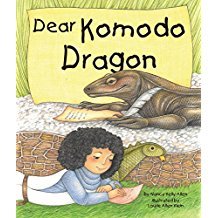 I wrote a picture book manuscript. Revised until my eyes threatened to cross. Pitched it to my critique partner for feedback. Revised again. Back to my critique partner, and revised again. Since most picture books have two components, pictures and text, the goal is to limit words to the bare essentials. The characters clothes, house, shoes don’t need to be described, unless vital to the story, because the illustrations will provide those. For writers who are not illustrators, it can be difficult to think visually, eliminating the aspects that can be shown through illustrations.
I wrote a picture book manuscript. Revised until my eyes threatened to cross. Pitched it to my critique partner for feedback. Revised again. Back to my critique partner, and revised again. Since most picture books have two components, pictures and text, the goal is to limit words to the bare essentials. The characters clothes, house, shoes don’t need to be described, unless vital to the story, because the illustrations will provide those. For writers who are not illustrators, it can be difficult to think visually, eliminating the aspects that can be shown through illustrations. Lack of description provides space for illustrators to carry the story beyond the text and to develop a variety of picture possibilities. Sometimes illustrations add a second story line. Focus the story on action and dialog. Dialog allows the emotion of the character to step off the page.Introduce characters that reflect the interest of the audience/age group. Move characters forward in the plot and into different settings. Vary the emotional intensity of scenes. With a maximum of 600 words or less, omitting description allows writers to delve deeper into the story in a short amount of space.Call for Submissions for Young Writers:Amazing Kids! Online Magazine. Do you love writing, art, photography or videography, and are between the ages of 5 to 18? Would you like to be published in the Amazing Kids! Online Magazine? Submit your writing and art; it might just be published in an upcoming issue!Send your name, age, and state/country when you send us your work. Please keep in mind we only accept kid-friendly, age-appropriate original creative works done by kids and teens. (The work must be appropriate for kids ages 12 and younger) and can be any of the following:Submission guidelines at http://mag.amazing-kids.org/get-involved/write-for-us/Call for Submissions for Adult Writers:East of the Web is keen to provide exposure for writers by offering them a place where their work will be seen and read in a high quality, respected setting. The site receives about half a million unique visitors per month, so successful submissions are likely to be viewed by more readers than in almost any other short story publication. In addition, the site receives attention from agents, the press, film makers, schools, universities and other publishers.Submission guidelines at http://www.eastoftheweb.com/short-stories/Publishing.htmlNancy Kelly Allen has written 40+ children’s books and a cookbook, SPIRIT OF KENTUCKY: BOURBON COOKBOOK.Leave a message or check out my blog at www.nancykellyallen.com
Published on April 15, 2018 07:15
April 2, 2018
Formatting a Picture Book
A writer, who is interested in picture books and asked about how to figure out pacing and how to divide the text onto pages, requested this blog.
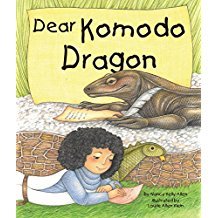
Picture books should written with page breaks in consideration. Most have 32 pages but with front and back matter only 27-28 pages are used for text, sometimes less. That leaves about 13-14 double-page spreads of illustrations and text. When writing take advantage of the page breaks. Possible ways to use them: Surprise the reader when the page is turned.
Vary the action so each double-page spread has a different scene and new action. One way I do this is to write the story; then divide it into 14 scenes. Of course, I have to revise, revise, revise to get pacing I need within the story segments. Some scenes may have too many words. My goal is to write 450 word or less. That number seems to be the “sweet spot” for most picture books. I also make a book dummy by folding 8 sheets of computer paper in half and stapling it. Front and back, the pages number 32. I print my completed manuscript, cut it with scissors and tape the text into the appropriate pages. This helps me know where the story does not work, where I need to rev up the surprises on page turns, or slow the action. I never submit a dummy or a manuscript with page breaks to a publisher unless it is specifically requested by the editor. Most publishers want standard format for submissions.
Call for Submissions for Young Writers: The Noisy Island seeks new and exciting work from high-school age students in the areas of fiction, poetry, and songs. We want to be an online journal that people actually read, so send us the type of work that you like to read and the type of music that you like to hear.
Submission guidelines at https://thenoisyisland.tumblr.com/about
Call for Submissions for Adult Writers: Spider Magazine , published by Cricket Media , seeks stories, poems, articles for children on theme of Over the Rainbow. "We would like to see warm family stories, an entire story without gender pronouns, children with different gender expressions, and gentle realistic or metaphorical coming out stories." Deadline: April 15, 2018.
Submission guidelines at http://cricketmedia.com/spider-submis... Kelly Allen has written 40+ children’s books and a cookbook, SPIRIT OF KENTUCKY: BOURBON COOKBOOK.
Leave a message or check out my blog at https://nancykellyallen.blogspot.com/

Picture books should written with page breaks in consideration. Most have 32 pages but with front and back matter only 27-28 pages are used for text, sometimes less. That leaves about 13-14 double-page spreads of illustrations and text. When writing take advantage of the page breaks. Possible ways to use them: Surprise the reader when the page is turned.
Vary the action so each double-page spread has a different scene and new action. One way I do this is to write the story; then divide it into 14 scenes. Of course, I have to revise, revise, revise to get pacing I need within the story segments. Some scenes may have too many words. My goal is to write 450 word or less. That number seems to be the “sweet spot” for most picture books. I also make a book dummy by folding 8 sheets of computer paper in half and stapling it. Front and back, the pages number 32. I print my completed manuscript, cut it with scissors and tape the text into the appropriate pages. This helps me know where the story does not work, where I need to rev up the surprises on page turns, or slow the action. I never submit a dummy or a manuscript with page breaks to a publisher unless it is specifically requested by the editor. Most publishers want standard format for submissions.
Call for Submissions for Young Writers: The Noisy Island seeks new and exciting work from high-school age students in the areas of fiction, poetry, and songs. We want to be an online journal that people actually read, so send us the type of work that you like to read and the type of music that you like to hear.
Submission guidelines at https://thenoisyisland.tumblr.com/about
Call for Submissions for Adult Writers: Spider Magazine , published by Cricket Media , seeks stories, poems, articles for children on theme of Over the Rainbow. "We would like to see warm family stories, an entire story without gender pronouns, children with different gender expressions, and gentle realistic or metaphorical coming out stories." Deadline: April 15, 2018.
Submission guidelines at http://cricketmedia.com/spider-submis... Kelly Allen has written 40+ children’s books and a cookbook, SPIRIT OF KENTUCKY: BOURBON COOKBOOK.
Leave a message or check out my blog at https://nancykellyallen.blogspot.com/
Published on April 02, 2018 10:17
March 18, 2018
Today’s Children’s Books
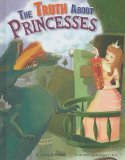 Diverse books are now in demand. Publishers are looking for books about children from different ethnic backgrounds who participate in everyday activities, not necessarily in an activity that showcases a different country or culture, but those are popular, too. Diverse books depict families and cultures, promoting understanding and acceptance.
Diverse books are now in demand. Publishers are looking for books about children from different ethnic backgrounds who participate in everyday activities, not necessarily in an activity that showcases a different country or culture, but those are popular, too. Diverse books depict families and cultures, promoting understanding and acceptance. Own Voices is also popular. The definition encompasses all forms of diversity, including disability, sexual orientation, and religion by authors who write about circumstances within their own experiences. This prevents glaring stereotypes or common misconceptions.
Write about a subject kids enjoy. What do kids like? I wrote a book, THE TRUTH ABOUT PRINCESSES, a nonfiction book focusing on fairy tale princesses. When I do book signings, little girls often reach for that book first.
Boys love trucks and cars and rocks. On a school visit, a parent asked me if I had a book on rocks. She said every time she did laundry, she found rocks in her son’s pants. Voila! An idea for a book. As it turns out, I did a six-book series on rocks. Other topics kids love are robots, ballerinas, heavy machinery, cowboys, super heroes, and animals. Listen to what parents and children request.
Notice what is not in the marketplace. One Sunday when I was employed as a librarian, I read an article about pink dolphins. The next day I checked the distributor’s list and could not find a book on the subject. Once again, voila! I had an idea for a book and a couple of years later, I held my literary baby, ON THE BANKS OF THE AMAZON, for the first time. Editors are intrigued with new and different topics.
Call for Submissions for Young Writers:Save the Earth Poetry Prize. Open to high school students, grades 11 & 12. Genre: Poem (1). Poems submitted should, in any way possible, evoke humankind’s awareness of the natural world and nature as such. Prize: $200 awarded to seven winners. Deadline: March 31, 2018.
Submissions guidelines at https://sites.google.com/site/savetheearthpoems/
Call for Submissions for Adult Writers:
Speculative Literature Foundation Older Writers Grand. Restrictions: Open to writers who are fifty years of age or older at the time of grant application. Genre: Speculative fiction. Prize: $500. Deadline: March 31, 2018.
Submissions guidelines at http://speculativeliterature.org/grants/slf-older-writers-grant/
Nancy Kelly Allen has written 40+ children’s books and a cookbook, SPIRIT OF KENTUCKY: BOURBON COOKBOOK.
Leave a message or check out my blog at www.nancykellyallen.com
Published on March 18, 2018 06:41
March 4, 2018
Getting Ideas and Writing a Book
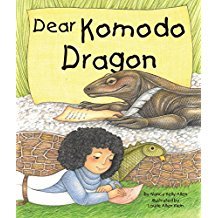 I had the wonderful opportunity to visit with students at an elementary school last week. Such visits inspire me to write more and to the best of my ability. Students' interest and questions spur me on.Two questions in particular resonated: How long does it take to write a book? How do you find ideas to write about?I wrestle with an idea anywhere from a week to years (thirteen years, as in the case of AMAZING GRACE). DEAR KOMODO DRAGON, my latest picture book, required less time, about two years. When I visited the Louisville Zoo, I saw a Komodo dragon named “Big Man.” At nearly eight-feet long, he lived up to his name. This king of the lizards wagged a long, yellow tongue and shuffled every step. A close look and a bit of imagination conjured my first instinct: write about this animal, whose ancient ancestors dated back millions of years. The species had staked its claim on planet Earth and held tight. A story had to be in there somewhere.I wrestled with the idea of how to write about this amazing animal in a way that had not been done. A few days later, I talked with a group of young students about what they enjoyed. One young girl said she loved to receive letters, but almost never did. The others echoed her, voicing the excitement of receiving their own mail. The two ideas—Komodo dragons and letters—simmered, scrambled, and stuck together. Out popped a brand new idea: a book about a Komodo dragon pen pal. Once I figured out the structure—a series of letters—I began brainstorming and outlining the plot. Since I knew almost nothing about Komodo dragons, I spent a lot of time researching facts. I gathered a basket full of information. From that, I selected the most interesting facts that would appeal to the readers. Each book is different and the amount of time to write a book varies.Call for Submissions for Young Writers:Storybook Online. Tons of activities including writing stories, read original stories, create interactive stories and much more.Submissions guidelines at http://www.storybookonline.net/Default.aspxCall for Submissions for Adult Writers:
Blue Mesa Review
accepts previously unpublished work in Fiction (up to 6,000 words), Nonfiction (up to 6,000 words), Poetry (up to 3 poems), and Visual Art. We have a rotating editorial board, so each issue is fresh and unique. In general, we are seeking strong voices and lively, compelling narrative with a fine eye for craft. We look forward to reading your best work!Submissions guidelines at https://bluemesareview.submittable.co...
I had the wonderful opportunity to visit with students at an elementary school last week. Such visits inspire me to write more and to the best of my ability. Students' interest and questions spur me on.Two questions in particular resonated: How long does it take to write a book? How do you find ideas to write about?I wrestle with an idea anywhere from a week to years (thirteen years, as in the case of AMAZING GRACE). DEAR KOMODO DRAGON, my latest picture book, required less time, about two years. When I visited the Louisville Zoo, I saw a Komodo dragon named “Big Man.” At nearly eight-feet long, he lived up to his name. This king of the lizards wagged a long, yellow tongue and shuffled every step. A close look and a bit of imagination conjured my first instinct: write about this animal, whose ancient ancestors dated back millions of years. The species had staked its claim on planet Earth and held tight. A story had to be in there somewhere.I wrestled with the idea of how to write about this amazing animal in a way that had not been done. A few days later, I talked with a group of young students about what they enjoyed. One young girl said she loved to receive letters, but almost never did. The others echoed her, voicing the excitement of receiving their own mail. The two ideas—Komodo dragons and letters—simmered, scrambled, and stuck together. Out popped a brand new idea: a book about a Komodo dragon pen pal. Once I figured out the structure—a series of letters—I began brainstorming and outlining the plot. Since I knew almost nothing about Komodo dragons, I spent a lot of time researching facts. I gathered a basket full of information. From that, I selected the most interesting facts that would appeal to the readers. Each book is different and the amount of time to write a book varies.Call for Submissions for Young Writers:Storybook Online. Tons of activities including writing stories, read original stories, create interactive stories and much more.Submissions guidelines at http://www.storybookonline.net/Default.aspxCall for Submissions for Adult Writers:
Blue Mesa Review
accepts previously unpublished work in Fiction (up to 6,000 words), Nonfiction (up to 6,000 words), Poetry (up to 3 poems), and Visual Art. We have a rotating editorial board, so each issue is fresh and unique. In general, we are seeking strong voices and lively, compelling narrative with a fine eye for craft. We look forward to reading your best work!Submissions guidelines at https://bluemesareview.submittable.co...Nancy Kelly Allen has written 40+ children’s books and a cookbook, SPIRIT OF KENTUCKY: BOURBON COOKBOOK.
Leave a message or check out my blog at www.nancykellyallen.com
Published on March 04, 2018 06:48
February 18, 2018
Writing a Book with a Relatable Theme
The theme is the dominant idea of a book, the author’s statement on which the story hangs. It is often expressed as the character’s learned experience, such as friendship, hope, love, sacrifice, or good over evil. Think of it as the main topic at the center of the story.
When I’m developing a story plot, I don’t think about theme. Instead, I focus on telling the story. If the theme becomes dominate at that stage of the writing process, it may force the characters into actions for the sake of the theme, rather than the plot.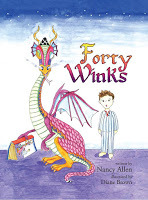 After I finish the first, sometimes the second or third draft, I usually develop a feeling of the theme that lies between the lines of the story. In Forty Winks, a bedtime story, multiple themes exist: fear of the dark, fear of monsters, benefits of sharing. The themes evolved from the story line, rather than the writing adhering to a particular message. When we write to promote a particular message, the story often becomes didactic, too instructive. My first rule for writing a fictional picture book is to focus on the entertainment value.I also ask the following questions: Is the theme relatable with wide appeal? Publishers want books that resonate with a large audience or age group. If a child enjoys a book and can “see” himself in the story, he wants to read it again, or another similar book. Is the theme an issue that’s important in the child’s world? Children often fear the dark, want to adopt a pet, or play with a friend. Consider the age of the audience before writing the first word. Themes vary with age groups. Fitting into a social group is a viable theme for middle grade and young adult readers, but don’t work as well for preschoolers.A theme is expressed through the ideas, thoughts, and actions of the character and is what the character learns in the journey of the story.Call for Submissions for Young Writers:
After I finish the first, sometimes the second or third draft, I usually develop a feeling of the theme that lies between the lines of the story. In Forty Winks, a bedtime story, multiple themes exist: fear of the dark, fear of monsters, benefits of sharing. The themes evolved from the story line, rather than the writing adhering to a particular message. When we write to promote a particular message, the story often becomes didactic, too instructive. My first rule for writing a fictional picture book is to focus on the entertainment value.I also ask the following questions: Is the theme relatable with wide appeal? Publishers want books that resonate with a large audience or age group. If a child enjoys a book and can “see” himself in the story, he wants to read it again, or another similar book. Is the theme an issue that’s important in the child’s world? Children often fear the dark, want to adopt a pet, or play with a friend. Consider the age of the audience before writing the first word. Themes vary with age groups. Fitting into a social group is a viable theme for middle grade and young adult readers, but don’t work as well for preschoolers.A theme is expressed through the ideas, thoughts, and actions of the character and is what the character learns in the journey of the story.Call for Submissions for Young Writers:
Hanging Loose magazine. High School Submissions.
* Send up to six poems or short stories, or an equivalent combination of poetry and prose.
Hanging Loose has long been known for its special interest in new writers. We read manuscripts throughout the year and we look forward to reading yours.
Submissions guidelines at http://hangingloosepress.com/submissions.html
Call for Submissions for Adult Writers:Nature Friend. "Nature-loving children and families get Nature Friend. We are primarily about wild nature. Can be animals, plants, birds, insects, rocks, ocean life, astronomy, gardening, learning by doing activities and experiments." Welcomes new writers. Circ. 7500. Monthly. Pays on publication. Period between acceptance and publication varies. Buy first rights. Accepts reprints. Responds quickly. Sample articles on website. Submissions guidelines at https://www.naturefriendmagazine.com/index.pl?linkid=12;class=gen.
Nancy Kelly Allen has written 40+ children’s books and a cookbook, SPIRIT OF KENTUCKY: BOURBON COOKBOOK. Leave a message or check out my blog at www.nancykellyallen.com
When I’m developing a story plot, I don’t think about theme. Instead, I focus on telling the story. If the theme becomes dominate at that stage of the writing process, it may force the characters into actions for the sake of the theme, rather than the plot.
 After I finish the first, sometimes the second or third draft, I usually develop a feeling of the theme that lies between the lines of the story. In Forty Winks, a bedtime story, multiple themes exist: fear of the dark, fear of monsters, benefits of sharing. The themes evolved from the story line, rather than the writing adhering to a particular message. When we write to promote a particular message, the story often becomes didactic, too instructive. My first rule for writing a fictional picture book is to focus on the entertainment value.I also ask the following questions: Is the theme relatable with wide appeal? Publishers want books that resonate with a large audience or age group. If a child enjoys a book and can “see” himself in the story, he wants to read it again, or another similar book. Is the theme an issue that’s important in the child’s world? Children often fear the dark, want to adopt a pet, or play with a friend. Consider the age of the audience before writing the first word. Themes vary with age groups. Fitting into a social group is a viable theme for middle grade and young adult readers, but don’t work as well for preschoolers.A theme is expressed through the ideas, thoughts, and actions of the character and is what the character learns in the journey of the story.Call for Submissions for Young Writers:
After I finish the first, sometimes the second or third draft, I usually develop a feeling of the theme that lies between the lines of the story. In Forty Winks, a bedtime story, multiple themes exist: fear of the dark, fear of monsters, benefits of sharing. The themes evolved from the story line, rather than the writing adhering to a particular message. When we write to promote a particular message, the story often becomes didactic, too instructive. My first rule for writing a fictional picture book is to focus on the entertainment value.I also ask the following questions: Is the theme relatable with wide appeal? Publishers want books that resonate with a large audience or age group. If a child enjoys a book and can “see” himself in the story, he wants to read it again, or another similar book. Is the theme an issue that’s important in the child’s world? Children often fear the dark, want to adopt a pet, or play with a friend. Consider the age of the audience before writing the first word. Themes vary with age groups. Fitting into a social group is a viable theme for middle grade and young adult readers, but don’t work as well for preschoolers.A theme is expressed through the ideas, thoughts, and actions of the character and is what the character learns in the journey of the story.Call for Submissions for Young Writers: Hanging Loose magazine. High School Submissions.
* Send up to six poems or short stories, or an equivalent combination of poetry and prose.
Hanging Loose has long been known for its special interest in new writers. We read manuscripts throughout the year and we look forward to reading yours.
Submissions guidelines at http://hangingloosepress.com/submissions.html
Call for Submissions for Adult Writers:Nature Friend. "Nature-loving children and families get Nature Friend. We are primarily about wild nature. Can be animals, plants, birds, insects, rocks, ocean life, astronomy, gardening, learning by doing activities and experiments." Welcomes new writers. Circ. 7500. Monthly. Pays on publication. Period between acceptance and publication varies. Buy first rights. Accepts reprints. Responds quickly. Sample articles on website. Submissions guidelines at https://www.naturefriendmagazine.com/index.pl?linkid=12;class=gen.
Nancy Kelly Allen has written 40+ children’s books and a cookbook, SPIRIT OF KENTUCKY: BOURBON COOKBOOK. Leave a message or check out my blog at www.nancykellyallen.com
Published on February 18, 2018 06:14



